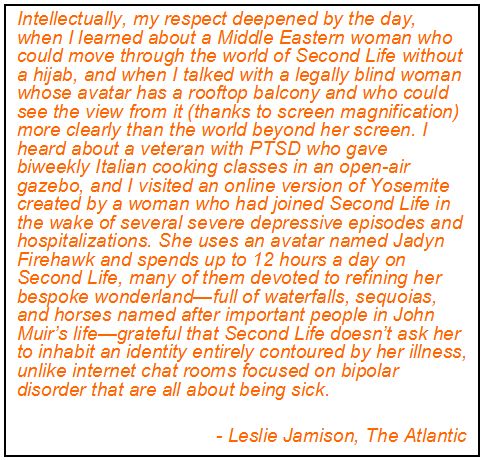
If there is one thing that can certainly be said concerning the news that Philip Rosedale has “returned to Second Life” is that over the last few weeks it has certainly generated a lot of interest from the media.
I’ve already covered articles on Rosedale, Second Life and his views on “the metaverse” from the likes of Protocol (see here)¹, and VentureBeat / GamesBeat, c|net, and The Wall Street Journal (see here)² – admittedly with some speculation on my part on the case of the latter. More recently Wired and others have also covered SL, Rosedale and “the Metaverse”, and he has been interviewed by CNN, CNBC (the latter of which I’ve yet to summarise), and most recently, by The Wall Street Journal once more.
The latter takes the form of a video segment – embedded below – that features Rosedale taking about Second Life, its users and “the metaverse”, whilst comparing and contrasting SL with plans voiced by the likes of Facebook / Meta and Microsoft and touching on the Lab’s hopes for SL – including further hints at the direction in which the company is leaning in terms of upping the platform’s appal to a broader audience.
Running to 20 seconds short of 6 minutes, the video is actually a concise and honest look at SL, and comes complete with a careful underlining of the age of some of the in-world footage used – a refreshing touch given that so often we are confronted with “archival” images / footage of the platform that get presented without any cage context, and so can leave people thinking they are looking at SL as it appears today.
Starting with Zuckerberg enthusiastically stating how people will all “work, learn, play, shop” in “the metaverse”, the piece quickly reminds viewers that for Second Life, all of that promise is very much a case of “already there and doing all of that, thank you!”. It then offers a fairly accurate recap of SL’s history in terms of early attractiveness, user engagement, and gradual (if somewhat low-key overall) resurfacing of interest (which predates all the current “metaverse” hype by around 24 months). As such, it neatly packages:
- The the history of SL and its longevity.
- The broad attractiveness people have found with the platform – notably the appeal of content creation and the power of the economy SL has forged.
- A frank, thumbnail look at some of the issues those coming into the platform face in trying to understand it (the IU, understanding avatar operation & customisation, finding others (particularly those of a like mind) with whom to interact, etc.
- Slightly conversely with the above, it also underscores the fact that while complex to understand, SL’s avatar system is still incredibly powerful and well beyond anything the likes of Meta are considering.
- The reiteration of the idea that virtual worlds down actually need VR or other headsets for engagement, and any focus on such hardware will, for a foreseeable future at least, remain a hurdle to potential engagement rather than a benefit
- The openness in allowing some doubt about all the current hype around “the metaverse” to be expressed.
- The underlining of LL’s approach to basic aspects of their platform in order to (hopefully) generate better user take-up and retention (e.g. improving performance, developing mobile support, improving (/simplifying) avatar user and the viewer’s UI).
The video also neatly encapsulates some of the problems “the metaverse” faces that appear to be outside of the thinking of Meta, etc. One of these is clearly stated by Rosedale: getting the vast majority of people simply comfortable with using avatars for tmany of their interactions. Like it or not, this is a stumbling block, and one Rosedale is correct in point out. Were it not, then after nigh-on 20 years, it would not be unfair to assume SL’s user base would likely be somewhat larger than its current 1 million active monthly users.
That said, this is also where the video is apparently a little too glib. In making the comparison between SL’s and Meta’s monthly active users (3.5 billion for the latter across its platforms), there is a suggestion that Meta has a big head start – but that’s hardly the case. If anything, I’d suggest the Meta has made its life that much harder compared to LL. Not only do they have to convince that 3.5 billion active user base of the need to swap away from doing much of what they do “in (first) person” – so to speak – to doing it with an avatar, they’ve also got to convince them to do so with a headset strapped to their faces. Given that currently, they probably have around 10 million headset users out of that 3.5 billion, they clearly have a huge mountain of their own to climb to get the rest to invest in headsets, even with a cash pot of up to US $10 billion to spend in doing so (which I assume includes money directly related to further headset development, etc.).
There are some wider holes in the piece that could be picked at – such as what the likes of Microsoft and Meta really mean by “interoperability” and the “movement of assets”, and whether, beyond some perfunctory basics they’ll really go down that path (after all, walled gardens are the best way to hold on to an audience – and their money); but at the end of the day this isn’t a piece on the metaverse per se. It’s about Second Life and its continuing relevance in the world today.
Footnotes
- Second Life’s founder doesn’t believe in VR, by Janko Roettgers and Nick Statt – Protocol,
- Philip Rosedale’s High Fidelity cuts deal with Second Life maker Linden Lab – Dean Takahashi, VentureBeat/GamesBeat; Second Life Founder Returns to Take On the Metaverse – Meghan Bobrowsky, Wall Street Journal (via Archive to avoid paywall); Second Life founder returns to revamp his original metaverse – Scott Stein, c|net











